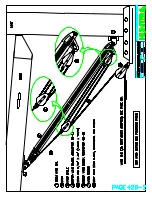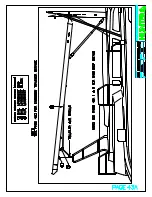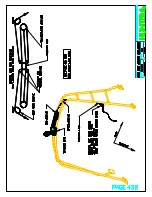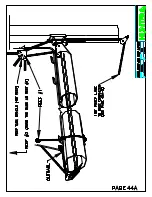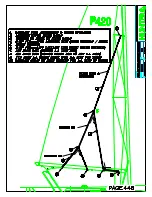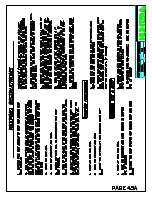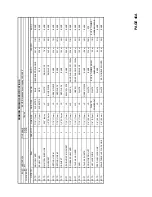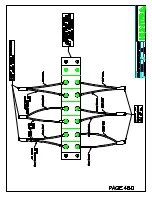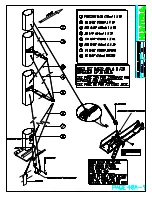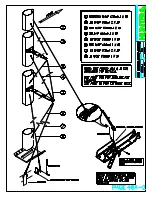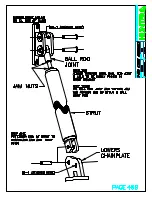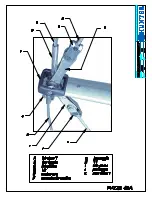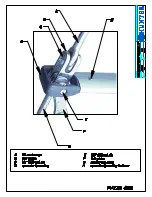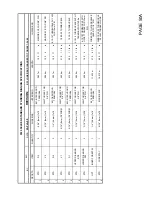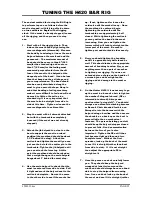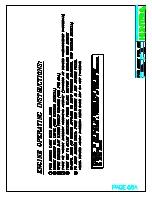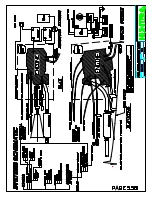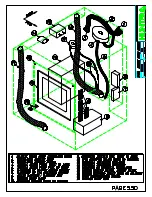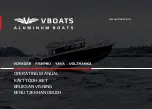
P420 B&R RIG WITH STRUTS DESCRIPTION
PAGE 47
The B&R rig, utilized on the Hunter
P420, eliminates the need for a
backstay to allow for a more efficient
mainsail shape. Fixed backstays are
commonly being designed out of today
’
s
performance-oriented boats to allow the
mainsail to incorporate a full roach
design - a more aerodynamic shape
both for racing and cruising
performance.
To accomplish this, the B&R rig has 30
degree swept spreaders, creating 120
degrees between each rigging point.
This tri-pod arrangement has excellent
strength for sailboat rigs, and has been
used for years to support huge radio
towers.
The latest advancement to the B&R rig
is the addition of mast struts. These
struts stabilize the lower section of the
mast, allowing compression loads to be
spread, reducing the point loading at the
mast base. They also create a strong
point for the boom and spinnaker pole
loadings. The struts function also allow
us to use a smaller mast section
reducing weight aloft to decrease the
heeling and pitching moments, making
for a more comfortable ride.
Additionally, they provide a secure
handhold when going forward.
The struts perform an important
structural function,
therefore never sail
your boat without the struts properly
fitted
. If your P420 is equipped with the
in-mast furling option, the mast is a
larger section size and the struts are not
utilized.
Additional support is given to the B&R
rig (and is unique to it) with the addition
of reverse diagonal rigging. For
example, the diagonals that you see
beginning by the top of the mast strut,
ending at the tip of the spreader,
supports and stabilizes the lower section
of the mast as it creates a triangle with
the lower shroud. The top RD2 runs
from above the lower spreader base to
the end of the top spreader, and
stabilizes the top section of the mast.
The B&R rig is designed to be pre-bent
to further add rigidity to the mast section
and eliminate the need for adjustable
rigging (like backstay adjusters). This
design should prove more reliable than
a rig with adjustable backstays or
runners, as there is less chance for
error.
The large main, small jib, sail plan on
the P420 also eliminates the need for
large overlapping headsails (genoas),
as the driving power comes from the
much improved shape and size of the
mainsail. This allows for an easier
tacking small jib, creating good
performance and more comfortable
sailing as it is less work for the crew.
As the large main is creating additional
mainsheet and leach loading, Hunter
has included a cockpit arch whereby the
mainsheet and leech loads are directed
to the strong part of the boom (the
outboard end) and is located at the
heaviest loading point of the mainsail.
The cockpit arch serves addition safety
and comfort functions as handholds and
cockpit canvas attachment points.
B&R rigs have been used on thousands
of sailboats, and we are proud to
incorporate this successful design on
your new Hunter.
Summary of Contents for sailing yacht
Page 28: ......
Page 39: ......
Page 40: ......
Page 41: ......
Page 43: ......
Page 46: ......
Page 47: ......
Page 48: ......
Page 49: ......
Page 50: ......
Page 51: ......
Page 52: ......
Page 53: ......
Page 54: ......
Page 55: ......
Page 56: ......
Page 57: ......
Page 58: ......
Page 59: ......
Page 62: ......
Page 63: ......
Page 64: ......
Page 65: ......
Page 67: ......
Page 68: ......
Page 69: ......
Page 70: ......
Page 71: ......
Page 74: ......
Page 77: ......
Page 78: ......
Page 79: ......
Page 80: ......
Page 81: ......
Page 82: ......
Page 83: ......
Page 84: ......
Page 85: ......
Page 86: ......
Page 87: ......
Page 88: ......
Page 89: ......
Page 90: ......
Page 91: ......
Page 92: ......
Page 93: ......
Page 94: ......
Page 95: ......
Page 96: ......
Page 97: ......
Page 98: ......
Page 99: ......
Page 100: ......
Page 101: ......
Page 102: ......
Page 103: ......
Page 104: ......
Page 105: ......
Page 106: ......
Page 107: ......
Page 108: ......
Page 109: ......
Page 110: ......
Page 111: ......
Page 112: ......
Page 113: ......
Page 117: ......
Page 118: ......
Page 119: ......
Page 122: ......
Page 123: ......
Page 124: ......
Page 129: ......
Page 130: ......
Page 131: ......
Page 132: ......
Page 133: ......
Page 134: ......
Page 135: ......
Page 136: ......
Page 137: ......
Page 138: ......
Page 139: ......
Page 140: ......
Page 141: ......
Page 142: ......
Page 143: ......
Page 144: ......
Page 145: ......
Page 146: ......
Page 147: ......
Page 148: ......
Page 149: ......
Page 150: ......
Page 151: ......
Page 152: ......
Page 153: ......
Page 154: ......
Page 155: ......
Page 156: ......
Page 157: ......
Page 158: ......
Page 159: ......
Page 160: ......
Page 161: ......
Page 162: ......
Page 163: ......
Page 164: ......
Page 165: ......
Page 166: ......
Page 167: ......
Page 168: ......
Page 169: ......
Page 170: ......
Page 171: ......
Page 174: ......
Page 175: ......
Page 176: ......
Page 177: ......
Page 178: ......
Page 179: ......
Page 180: ......

